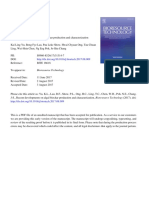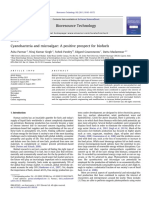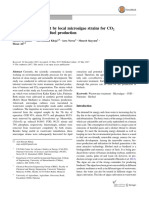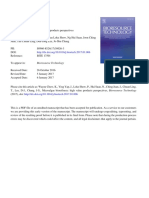Phycoremediation and Biogas Potential of Native Algal Isolates From Soil and Wastewater
Phycoremediation and Biogas Potential of Native Algal Isolates From Soil and Wastewater
Uploaded by
sanjukecCopyright:
Available Formats
Phycoremediation and Biogas Potential of Native Algal Isolates From Soil and Wastewater
Phycoremediation and Biogas Potential of Native Algal Isolates From Soil and Wastewater
Uploaded by
sanjukecOriginal Description:
Original Title
Copyright
Available Formats
Share this document
Did you find this document useful?
Is this content inappropriate?
Copyright:
Available Formats
Phycoremediation and Biogas Potential of Native Algal Isolates From Soil and Wastewater
Phycoremediation and Biogas Potential of Native Algal Isolates From Soil and Wastewater
Uploaded by
sanjukecCopyright:
Available Formats
Author's personal copy
Bioresource Technology 135 (2013) 232238
Contents lists available at SciVerse ScienceDirect
Bioresource Technology
journal homepage: www.elsevier.com/locate/biortech
Phycoremediation and biogas potential of native algal isolates from soil and wastewater
Sanjeev Kumar Prajapati, Prachi Kaushik, Anushree Malik , Virendra Kumar Vijay
Centre for Rural Development and Technology, Indian Institute of Technology, Delhi, Hauz Khas, New Delhi 110016, India
h i g h l i g h t s
" Pioneering study to integrate phycoremediation and biogas production. " First report on phycoremediation and biogas potential of terrestrial and aquatic alga. " More than 70% reduction in COD by algal isolates. " Good synergy of algal isolates with native microbes in phycoremediation. " Biogas yield in the range of 0.4010.487 m Kg
3 1
VS added.
a r t i c l e
i n f o
a b s t r a c t
The present study is a novel attempt to integrate phycoremediation and biogas production from algal biomass. Algal isolates, sp. 1 and sp. 2, obtained from wastewater and soil were evaluated for phycoremediation potential and mass production. The estimated yield was 58.4 sp. 1 and 54.75 sp. 2 tons ha1 y1. The algal isolates reduced COD by >70% and NH3-N by 100% in unsterile drain wastewater. Higher productivities of sp. 1 (1.05 g L1) and sp. 2 (0.95 g L1) grown in wastewater compared to that grown in nutrient media (0.89 g L1 for sp. 1 and 0.85 g L1 for sp. 2) indicate the potential of algal isolates in biogas production through low cost mass cultivation. Biogas yield of 0.4010.487 m3 kg1 VS added with 5254.9% (v/v) methane content was obtained for algal isolates. These results indicate the possibilities of developing an integrated process for phycoremediation and biogas production using algal isolates. 2012 Elsevier Ltd. All rights reserved.
Article history: Available online 27 August 2012 Keywords: BMP Biogas yield Chroococcus sp. Phycoremediation Volatile solid reduction
1. Introduction Over the years, the global demand for energy has increased considerably and is being mainly met through conventional energy sources. The current renewable energy resources such as solar, wind, hydro, geothermal and biomass (Converti et al., 2009), represent up to 14% of primary-energy consumption in the world. Out of this, biomass contributes approximately 10% of the renewable energy resources (Antizan-Ladislao and Turrion-Gomez, 2008). Algal biomass has a number of potential advantages over higher plants as a biofuel feedstock. Although algae grow in aqueous media but need less amount of water than terrestrial biomass (Rodol et al., 2009). Algae have higher growth rate and are capable of bio-xing waste/ biogas CO2 (Chisti, 2007; Mandal and Mallick, 2009). In spite of these advantages, the economics of the processes
Corresponding author. Tel.: +91 11 26591158; fax: +91 11 26591121.
E-mail addresses: sanjukec@gmail.com (S.K. Prajapati), kaushik.prachi@yahoo. com (P. Kaushik), anushree_malik@yahoo.com, anushree@rdat.iitd.ac.in (A. Malik), vkvijay14@hotmail.com, vkvijay@rdat.iitd.ernet.in (V.K. Vijay). 0960-8524/$ - see front matter 2012 Elsevier Ltd. All rights reserved. http://dx.doi.org/10.1016/j.biortech.2012.08.069
makes most algal-based technologies unviable in the long run as the cost of algae production (nutrient supplementation) and processing for biofuel production is comparatively high (Chisti, 2007). However, the cost of algal biomass production can be reduced if the nutrient requirement is met through the nutrients present in wastewater. Algae have been utilized for the treatment of variety of industrial and municipal wastewater (Markou and Georgakakis, 2011; Phang et al., 2000; Rawat et al., 2011). The possibility of algal biomass production in wastewaters for biofuel feedstocks, is being increasingly explored (Rawat et al., 2011; Sturm and Lamer, 2011). Once the algal biomass is generated, it can be used to produce biodiesel, ethanol, hydrogen, biogas or direct burning based on its characteristics (Chisti, 2007; Sturm and Lamer, 2011). However, the high processing cost of algal biomass (e.g., dewatering, oil extraction etc.) makes algal biofuel production economically unviable (Singh and Gu, 2010). Minimal processing of algal biomass is required prior to biogas production which makes it an attractive option. Algal biomass contains considerable amount of biodegradable components such as carbohydrates, lipids and proteins. This makes it a favorable substrate for anaerobic microbial ora and
You might also like
- Environmental Key Performance IndicatorsDocument68 pagesEnvironmental Key Performance Indicatorssb3stripes100% (6)
- 8Document12 pages8JaeDukAndrewSeo100% (1)
- Development of Renewable Energy Based Green Hydrogen and Oxygen Production and Electricity Generation Systems For Sustainable AquacultureDocument12 pagesDevelopment of Renewable Energy Based Green Hydrogen and Oxygen Production and Electricity Generation Systems For Sustainable AquacultureGabriela RochaNo ratings yet
- BiofuelsDocument3 pagesBiofuelsapi-266862163No ratings yet
- 1-s2.0-S221192642400256X-mainDocument13 pages1-s2.0-S221192642400256X-mainromainbissessar3No ratings yet
- Wang2016 Microalgal For Insdustrial Wastewater TreatmentDocument52 pagesWang2016 Microalgal For Insdustrial Wastewater TreatmentSacra PsyntergiaNo ratings yet
- Symbiotic Integration of BioprocessDocument12 pagesSymbiotic Integration of BioprocessLauraNo ratings yet
- 3 - Resource Recovery From Wastewaters Using Microalgae-Based ApproachesDocument15 pages3 - Resource Recovery From Wastewaters Using Microalgae-Based ApproachesElena Rojo de BenitoNo ratings yet
- Microalgae As Substrates For Fermentative Biogas Production in A Combined Biorefinery ConceptDocument6 pagesMicroalgae As Substrates For Fermentative Biogas Production in A Combined Biorefinery ConceptBalakumar KarthikeyanNo ratings yet
- J of Chemical Tech Biotech - 2020 - Zou - Emerging Technologies of Algae Based Wastewater Remediation For Bio FertilizerDocument13 pagesJ of Chemical Tech Biotech - 2020 - Zou - Emerging Technologies of Algae Based Wastewater Remediation For Bio FertilizerFarooq KhanNo ratings yet
- Life cycle assessment_ Sustainability of biodiesel production from black soldier fly larvae feeding on thermally pre-treated sewage sludge under a tropical country settingDocument12 pagesLife cycle assessment_ Sustainability of biodiesel production from black soldier fly larvae feeding on thermally pre-treated sewage sludge under a tropical country settingRifyal MulkanNo ratings yet
- Science of The Total EnvironmentDocument17 pagesScience of The Total EnvironmentElena Rojo de BenitoNo ratings yet
- Renewable Energy: Sarto Sarto, Raudati Hildayati, Iqbal SyaichurroziDocument16 pagesRenewable Energy: Sarto Sarto, Raudati Hildayati, Iqbal SyaichurroziManuel MontañezNo ratings yet
- Accepted Manuscript: Bioresource TechnologyDocument43 pagesAccepted Manuscript: Bioresource TechnologyĐoàn NgọcNo ratings yet
- HTC To H2Document13 pagesHTC To H2sigit cahyonoNo ratings yet
- 2014-A Critical Analysis For Microalgal Biofuel Production at Commercial ScaleDocument13 pages2014-A Critical Analysis For Microalgal Biofuel Production at Commercial ScalereaktorenergiNo ratings yet
- Review BiocharDocument10 pagesReview BiocharLeynard NatividadNo ratings yet
- 2020 - Outdoor Cultivation of Chlorella Sorokiniana in Third GenerationDocument7 pages2020 - Outdoor Cultivation of Chlorella Sorokiniana in Third GenerationGeanelly SALGADO URIOSTEGUINo ratings yet
- AlgasDocument25 pagesAlgasDayanneNo ratings yet
- Design and Selection Criteria of Biogas DigesterDocument22 pagesDesign and Selection Criteria of Biogas DigesterYaser ObaidiNo ratings yet
- Advancement of Green Technologies - A Comprehensive Review On The Potential Application of Microalgae BiomassDocument15 pagesAdvancement of Green Technologies - A Comprehensive Review On The Potential Application of Microalgae Biomassbambang_teknikkimiaNo ratings yet
- 1 s2.0 S0961953421001562 MainDocument13 pages1 s2.0 S0961953421001562 MainDavid AfricanoNo ratings yet
- Biohydrogen Production ChapterDocument29 pagesBiohydrogen Production Chapterleo786vss2006No ratings yet
- Water Use and Its Recycling in Microalgae Cultivation For Biofuel ApplicationDocument9 pagesWater Use and Its Recycling in Microalgae Cultivation For Biofuel ApplicationStefano CarreñoNo ratings yet
- Articulo BiorefineriasDocument10 pagesArticulo Biorefineriasthato69No ratings yet
- Parmar2011 PDFDocument10 pagesParmar2011 PDFsaima afridiNo ratings yet
- Applied Energy: Sanjeev Kumar Prajapati, Anushree Malik, Virendra Kumar VijayDocument1 pageApplied Energy: Sanjeev Kumar Prajapati, Anushree Malik, Virendra Kumar VijaysanjukecNo ratings yet
- REPORTDocument10 pagesREPORTSudip ShresthaNo ratings yet
- Microalgal Drying and Cell Disruption - Recent AdvancesDocument9 pagesMicroalgal Drying and Cell Disruption - Recent AdvancesJuan Diego Cárdenas100% (1)
- 1 s2.0 S0960852422010203 MainDocument16 pages1 s2.0 S0960852422010203 MainJuan VeraNo ratings yet
- Effectiveness of Algae in Wastewater Treatment SystemsDocument9 pagesEffectiveness of Algae in Wastewater Treatment SystemsIJRASETPublicationsNo ratings yet
- Poo - Fertilizer or Energy - Prasad Dietrich WielengaDocument7 pagesPoo - Fertilizer or Energy - Prasad Dietrich WielengaprasadjdwNo ratings yet
- Good - Co-Pelletization of Sewage Sludge and Agricultural WastesDocument7 pagesGood - Co-Pelletization of Sewage Sludge and Agricultural WastesgftalerorNo ratings yet
- Bioresource Technology: Wasif Farooq, William I. Suh, Min S. Park, Ji-Won YangDocument9 pagesBioresource Technology: Wasif Farooq, William I. Suh, Min S. Park, Ji-Won YangKeli SobralNo ratings yet
- 1 s2.0 S2405844024072013 MainDocument28 pages1 s2.0 S2405844024072013 Maincamilobermudez.pinturasmundialNo ratings yet
- Park Et Al. 2011a Estanques de Al Algas para Tratamiento para Produccion de BiodiselDocument8 pagesPark Et Al. 2011a Estanques de Al Algas para Tratamiento para Produccion de BiodiselAlexis Hugo Hernández PérezNo ratings yet
- Energies-14-08157Document17 pagesEnergies-14-08157yorimNo ratings yet
- Chen 2020Document10 pagesChen 2020Vinicios SantosNo ratings yet
- Algae Biorefinery - A Promising Approach To Promote Microalgae Industry and Waste UtilizationDocument16 pagesAlgae Biorefinery - A Promising Approach To Promote Microalgae Industry and Waste UtilizationBernardo RodriguesNo ratings yet
- 1 s2.0 S0960852418301135 MainDocument7 pages1 s2.0 S0960852418301135 MainPsyduck 2003No ratings yet
- Utilization of Microalgal Bacterial Energy Nexus Improves - 2023 - EcotoxicologyDocument16 pagesUtilization of Microalgal Bacterial Energy Nexus Improves - 2023 - EcotoxicologyCristhian RodriguezNo ratings yet
- Elsevier Paper in Bioresources TechnologyDocument9 pagesElsevier Paper in Bioresources TechnologyMeshach AlfaNo ratings yet
- Harshal WaradeDocument21 pagesHarshal WaradeHarshal WaradeNo ratings yet
- 1-s2.0-S0960852422016650-mainDocument12 pages1-s2.0-S0960852422016650-mainareebaurooj288No ratings yet
- Evaluation of Operating Conditions For S PDFDocument7 pagesEvaluation of Operating Conditions For S PDFMartin DarmasetiawanNo ratings yet
- Algal Biorefinery - An Integrated Approach For Sustainable Biodiesel ProductionDocument16 pagesAlgal Biorefinery - An Integrated Approach For Sustainable Biodiesel ProductionCarlos GamarraNo ratings yet
- Bioresource Technology: SciencedirectDocument9 pagesBioresource Technology: Sciencedirectsushmita karNo ratings yet
- Ansari2017 Article WastewaterTreatmentByLocalMicrDocument8 pagesAnsari2017 Article WastewaterTreatmentByLocalMicrLissette RamosNo ratings yet
- Progress in Microalgae Application For CO2 SequestDocument41 pagesProgress in Microalgae Application For CO2 SequestGOPU3699No ratings yet
- Emerging Technologies For Biofuel Production A Critical Review On Recent Progress, Challenges and PerspectivesDocument16 pagesEmerging Technologies For Biofuel Production A Critical Review On Recent Progress, Challenges and PerspectivesbabulladriveNo ratings yet
- Research Paper No. 3Document9 pagesResearch Paper No. 3J LNo ratings yet
- Golinski2015 MicroalgaeDocument14 pagesGolinski2015 MicroalgaeTeresa MataNo ratings yet
- Ees 2016 0132Document17 pagesEes 2016 0132GREENLAB ECL TECHNo ratings yet
- Biogas EnergyDocument6 pagesBiogas EnergyHayan JanakatNo ratings yet
- Bioresource Technology: Martin Gross, Wesley Henry, Clayton Michael, Zhiyou WenDocument7 pagesBioresource Technology: Martin Gross, Wesley Henry, Clayton Michael, Zhiyou WenEdgar Duvan Valencia SanchezNo ratings yet
- Test PDFDocument9 pagesTest PDFPragadeesh SekarNo ratings yet
- Haba Shy 2021Document15 pagesHaba Shy 2021nataliaimeldawNo ratings yet
- 1 s2.0 S0960852410015063 MainDocument8 pages1 s2.0 S0960852410015063 MainMaria SolNo ratings yet
- 1 s2.0 S2666790822000714 MainDocument8 pages1 s2.0 S2666790822000714 MainPutriNo ratings yet
- Microalgae BiorefineryDocument43 pagesMicroalgae BiorefineryMauro Batalha100% (2)
- Renewable and Sustainable Energy Reviews: Laurencas Raslavi Čius, Nerijus Stri Ūgas, Mantas FelnerisDocument12 pagesRenewable and Sustainable Energy Reviews: Laurencas Raslavi Čius, Nerijus Stri Ūgas, Mantas FelnerisGirard Immanuel SorianoNo ratings yet
- Benefits of Bioplastics' BiodegradabilityDocument9 pagesBenefits of Bioplastics' BiodegradabilityAngelo ErminoNo ratings yet
- English SPM: Project of Stri-LenceDocument21 pagesEnglish SPM: Project of Stri-LenceJolin ChaijiaxuanNo ratings yet
- Week-1 Material - Introduction To SWMDocument126 pagesWeek-1 Material - Introduction To SWMSandeep MahajanNo ratings yet
- C SBM Toolkit For Swachh Survekshan 2023Document112 pagesC SBM Toolkit For Swachh Survekshan 2023coolnidhi134558100% (1)
- Science 5 - Q1 - W5Document6 pagesScience 5 - Q1 - W5Mathleen DescalzoNo ratings yet
- Considerations For Effective Tailings Dam Breach Analysis Study For Risk AssessmentDocument41 pagesConsiderations For Effective Tailings Dam Breach Analysis Study For Risk AssessmentDr. Partha Sarathi ParhiNo ratings yet
- Method Statement FOR Waste Polymer Slurry Disposal: PT Bauer Pratama IndonesiaDocument4 pagesMethod Statement FOR Waste Polymer Slurry Disposal: PT Bauer Pratama IndonesiaFendi Rang TigorNo ratings yet
- Experimental Study On Stabilization of Black Cotton Soil Using Textile Sludge Waste Treated With Hydrated LimeDocument5 pagesExperimental Study On Stabilization of Black Cotton Soil Using Textile Sludge Waste Treated With Hydrated LimeYoris R ChannelNo ratings yet
- Project ProposalDocument4 pagesProject ProposalAndrea Mae AmanteNo ratings yet
- A Project Reprot On Awareness of Labour Laws at Gokak MillsDocument82 pagesA Project Reprot On Awareness of Labour Laws at Gokak MillsBabasab Patil (Karrisatte)No ratings yet
- City Development Plan PDFDocument214 pagesCity Development Plan PDFKarthiga MohanNo ratings yet
- Demolition Code of Practice) PDFDocument145 pagesDemolition Code of Practice) PDFknabpshoNo ratings yet
- Panasonic DMW-FL220 FlashDocument128 pagesPanasonic DMW-FL220 FlashdeejjjaaaaNo ratings yet
- Good Food For All Agenda 2017Document48 pagesGood Food For All Agenda 2017LA Food Policy CouncilNo ratings yet
- DM-PH&SD-P7-WI14 - (Health Requirements For Shopping Malls & Centers)Document5 pagesDM-PH&SD-P7-WI14 - (Health Requirements For Shopping Malls & Centers)narma143No ratings yet
- Climate Change Initiatives in GujaratDocument1 pageClimate Change Initiatives in GujaratBaldev MakwanaNo ratings yet
- Compact NSX (2015)Document228 pagesCompact NSX (2015)hmha83No ratings yet
- Andreas FroeseDocument7 pagesAndreas FroeseKavi PrabhuNo ratings yet
- KSWM - 3rd Year (New)Document21 pagesKSWM - 3rd Year (New)Sandy TrumpNo ratings yet
- BIO MASS AND ALTERNATIVE ENERGY SUPPLIERS AND BIOMASS at GlanceDocument11 pagesBIO MASS AND ALTERNATIVE ENERGY SUPPLIERS AND BIOMASS at GlanceSUPER INDUSTRIAL ONLINENo ratings yet
- Genesol 34 MSDSDocument3 pagesGenesol 34 MSDSgulfengsolutionsNo ratings yet
- Fire Protection Pipes Method StatementDocument16 pagesFire Protection Pipes Method StatementAbdul Hakkim80% (5)
- Concrete Recycling-1 PDFDocument56 pagesConcrete Recycling-1 PDFPRASHANTHNo ratings yet
- Common Infections and Infestations in HousekeepingDocument4 pagesCommon Infections and Infestations in HousekeepingJesca IthewaNo ratings yet
- Five Day - Biochemical Oxygen DemandDocument21 pagesFive Day - Biochemical Oxygen DemandAG-Metal /Tretman Otpadnih Voda/Wastewater TreatmentNo ratings yet
- Internship ReportDocument11 pagesInternship ReportgeorgeNo ratings yet
- Cost Concept in Inventory ManagementDocument30 pagesCost Concept in Inventory Managementaharish_iitkNo ratings yet
- Coastal Regulation Zone Notification (CRZ)Document15 pagesCoastal Regulation Zone Notification (CRZ)Sagar ApteNo ratings yet

























































































